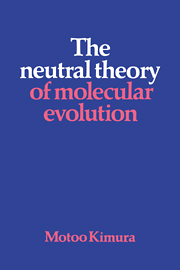Book contents
- Frontmatter
- Contents
- Preface
- Introduction
- 1 From Lamarck to population genetics
- 2 Overdevelopment of the synthetic theory and the proposal of the neutral theory
- 3 The neutral mutation-random drift hypothesis as an evolutionary paradigm
- 4 Molecular evolutionary rates contrasted with phenotypic evolutionary rates
- 5 Some features of molecular evolution
- 6 Definition, types and action of natural selection
- 7 Molecular structure, selective constraint and the rate of evolution
- 8 Population genetics at the molecular level
- 9 Maintenance of genetic variability at the molecular level
- 10 Summary and conclusion
- References
- Author Index
- Subject Index
8 - Population genetics at the molecular level
Published online by Cambridge University Press: 05 August 2012
- Frontmatter
- Contents
- Preface
- Introduction
- 1 From Lamarck to population genetics
- 2 Overdevelopment of the synthetic theory and the proposal of the neutral theory
- 3 The neutral mutation-random drift hypothesis as an evolutionary paradigm
- 4 Molecular evolutionary rates contrasted with phenotypic evolutionary rates
- 5 Some features of molecular evolution
- 6 Definition, types and action of natural selection
- 7 Molecular structure, selective constraint and the rate of evolution
- 8 Population genetics at the molecular level
- 9 Maintenance of genetic variability at the molecular level
- 10 Summary and conclusion
- References
- Author Index
- Subject Index
Summary
Why a stochastic treatment is required
This chapter is intended to serve as a preliminary to the next chapter where the mechanism for the maintenance of genetic variability at the molecular level will be discussed. Since the neutral theory treats intraspecific variability as one aspect of the stochastic theory of molecular evolution, it is essential to have a good understanding of the stochastic theory, particularly as it is applied to molecular mutants in finite populations. Actually, I have already presented some accounts of the theory, notably in chapter 3, and also in section 6.8 of chapter 6. In this chapter I shall present more systematically the relevant aspects of the theory treating gene frequency changes as stochastic processes, where the term stochastic process means the mathematical formulation of chance events proceeding in time.
The necessity of stochastic treatment stems from the uniqueness of mutations and the finiteness of populations; it comes from the fact that individual molecular mutants are practically unique because of their exceedingly low incidence, so that in a finite population their fates are largely controlled by the random sampling of gametes in reproduction (see chapter 3).
To see these points in more concrete terms, let us consider a hypothetical mammalian population whose generation length is exactly one year, and which comprises a hundred thousand individuals each year.
- Type
- Chapter
- Information
- The Neutral Theory of Molecular Evolution , pp. 194 - 252Publisher: Cambridge University PressPrint publication year: 1983
- 1
- Cited by

